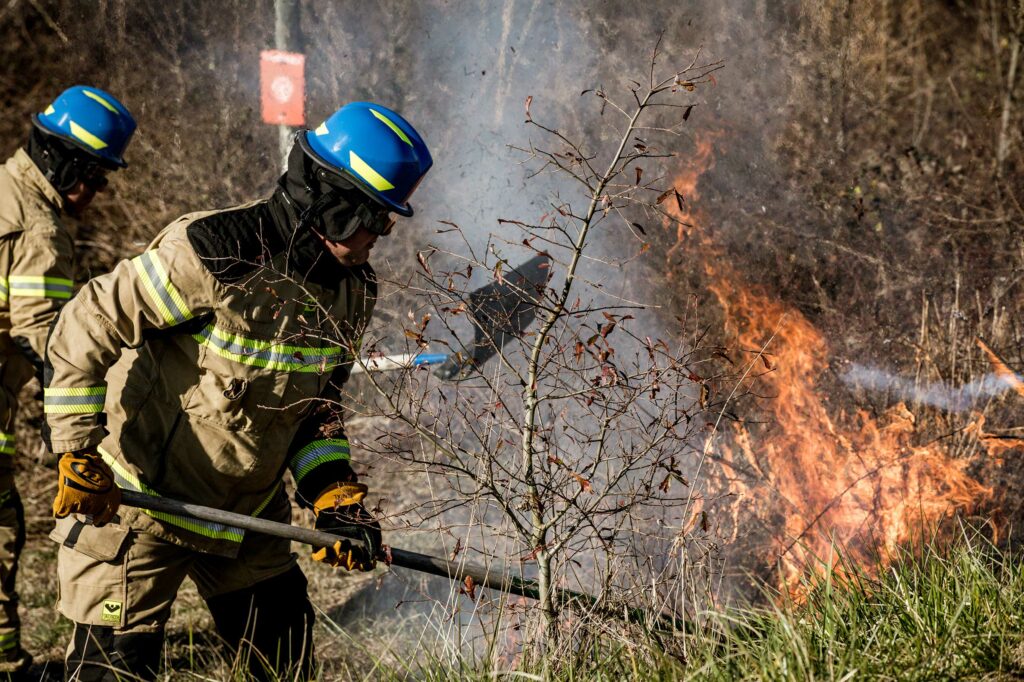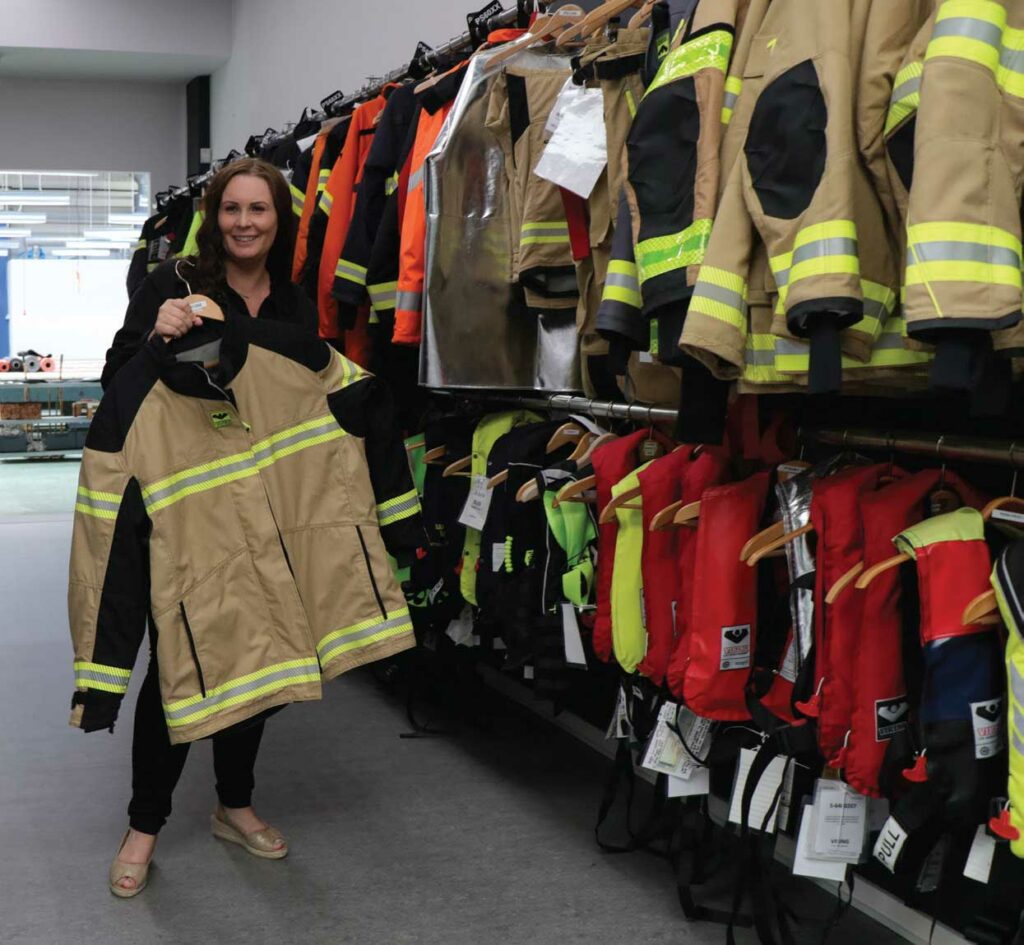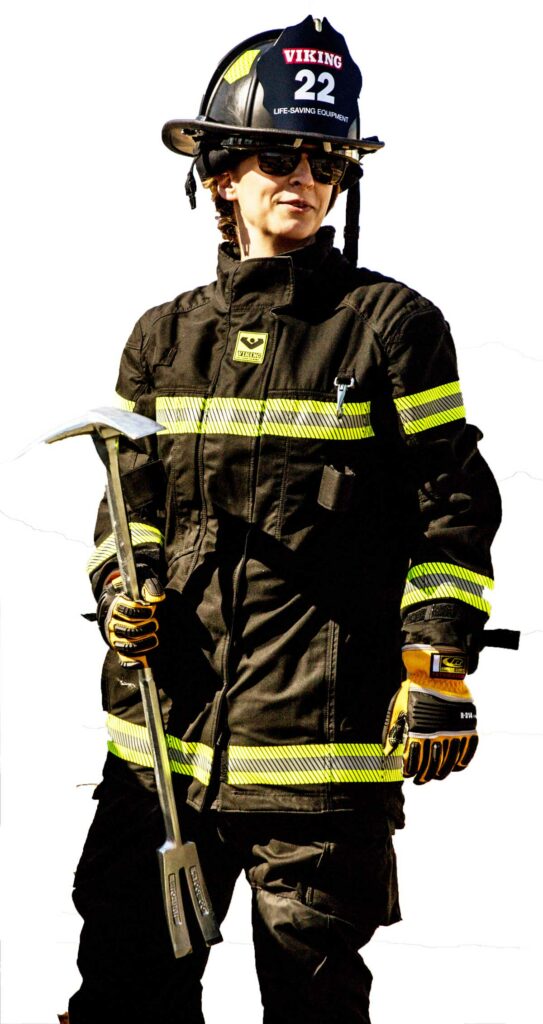Meeting the Need for Fit-To-Purpose Turnout Gear to serve Multiple Purposes

Sponsored Content from VIKING
Structural firefighting turnout gear has its place in the fire service, without a doubt, but it’s not the best protection for most rescue work and it certainly doesn’t belong on the scene of a wildland fire.
Most fire departments in the United States can’t afford to have multiple sets of Personal Protective Equipment (PPE) available for each first responder for every situation.
Climate change has sparked more, and larger, wildland fires. Firefighters are also increasingly aware of health risks from exposure to bloodborne pathogens they might encounter on a vehicle extrication or emergency rescue operation.
VIKING Life-Saving Equipment recognized the issues and developed a solution – one set of gear for multiple purposes called the VIKING SHIELD. The fit-for-purpose modular gear is the only PPE certified by Underwriters’ Laboratories to be compliant with the National Fire Protection Association (NFPA) 1977, 1951 and 1999 standards offering optional full bloodborne pathogen protection, for wildland, technical rescue and emergency medical operations, respectively.


MODULAR SYSTEM
Grant Grinstead, VIKING’s Fire Segment Key Account and Product Manager for North America, explained that the VIKING SHIELD modular system employs a Gore® SR moisture barrier liner that snaps into the SHIELD gear with watertight snaps to provide the user with protection from water ingress, bloodborne pathogens and many chemicals.

“The VIKING SHIELD is unique in design in the fact that it is a modular system which means that you can have it staged at all times on your apparatus or in your garment locker with the Gore® SR liner in it for vehicle extrications and emergency medical operations which require a little faster response. If you get toned out for a wildland-type situation, you just snap out the Gore® SR liner and it turns into a fully compliant NFPA 1977 wildland garment,” Grinstead said.
“So, you basically have three uses for this garment if you purchase it with that component.”
The key to the VIKING SHIELD is the Gore® SR moisture barrier. Grinstead explained it is very much like the barrier used in structural turnout gear. It’s a lightweight film laminated to a substrate to make the barrier more durable and tear resistant.
“It’s about the thickness of two sheets of printer paper,” Grinstead said. “It’s smooth and very comfortable on your skin.” He added that it is held in place as a liner with watertight snaps making it very easy to snap apart and remove and replace as needed. In place, it is fully compliant for extrication and emergency medical operations. Removed, it reduces the vapor barrier associated with it, making it compliant for wildland firefighting.
The beauty of the system is the Gore® SR barrier provides the protection from bloodborne pathogens and many chemicals that might be encountered during rescues but can be removed to meet the Total Heat Loss (THL) requirements for use in wildland firefighting, Grinstead said.
“In an extended technical rescue, a wildland fire, or a confined space rescue, you could take the liner out because you are not expecting to see the exposure to the bloodborne pathogens so you could wear the gear for a much longer period of time,” Grinstead said. “… The Gore® SR barrier is for protection for vehicle extrication, emergency medical operations and high-risk evolutions.”
The outer shell of the VIKING SHIELD gear is made from a Safety Component’s Sigma with a comfort twill weave and unique blend of fibers to provide all the flame spread and fire resistance required for NFPA standards for compliance.
EXCEEDING NFPA STANDARDS
Building quality PPE doesn’t stop with using the best materials available for VIKING. The company is laser focused on fit and finish for all its gear, including the new VIKING SHIELD.
“All good gear starts with a lot of research,” said Camilla Callesen, the NFPA Development and Design Manager for VIKING. “Firefighters are dedicated, hardworking men and women and we need to make sure the gear we design is a better quality than what’s on the market. So, we don’t do the same as everyone else. Many people want us to do things faster, but good quality gear takes time to make.”
“If it fits better, and feels better, you will be able to wear it longer,” Grinstead said. “This one is not going to build up the heat like structural firefighting gear would when used in the same situation.” Many people don’t realize that NFPA standards dictate some of the manufacturing details like seam, cuff and hem sizes, Grinstead said. And Callesen added that VIKING does a lot of research to develop just the right collar, thigh, and knee widths, among others, to make the most comfortable fitting gear available.
To that end, the VIKING SHIELD gear is tailored to fit the responders, and not just available in small, medium, large, and extra-large sizes like typical gear used for wildland firefighting.
“We can do better,” Callesen said. “We want to have the gear as light and fitted as we can, but without compromising the safety of the firefighters.” Grinstead said VIKING SHIELD gear, like all the other VIKING products is ergonomically designed to fit the responders and give them the comfort and range of motion they need to do their jobs.
“When we develop our gear, we do it in close cooperation with firefighters and conduct wear trials to evaluate the gear in real situations.”
DETAILS MAKE A DIFFERENCE

Other details that set the VIKING gear apart from competitors is not only the high-quality fabrics, but attention to quality in key details that provide more comfort in the shoulder area such as shoulder padding to make it more comfortable, the creative design of the sleeves to conform to wildland standards, removable liners with watertight snaps and lay-flat pockets on the pants and coats.
VIKING even thought of a new way of treating the pant cuffs.
“One of the coolest things you’ll see on the pants that you won’t see on others is the boot accessibility,” Grinstead said. “The zipper is on the back of the pant leg rather than on the sides. Much more comfortable when you’re sitting down, and you can reach the zipper more easily.” Additionally, the 10-inch zipper placed on the back of the pant leg is less inclined than side zippers to collect mud and debris, he said. VIKING even thought about adding optional suspender attachment loops to the pants in addition to the standard belt loops. Bellowed cargo and box pockets are also available on the VIKING SHIELD pants.
An optional durable Kevlar® product is used to reinforce elbows and cuffs on the coat and knees and pant leg hems on the pants.
An optional removable name panel is also available for the coats. Heat-applied lettering can be affixed to it or the back of the coat as the customer chooses. When it comes to color, the VIKING SHIELD line of gear is available in traditional tan, black and dark navy blue. Customers can choose dual color garments to create negative space to help to make responders more visible during operations.
VIKING uses highly breathable 3M® FR Comfort Trim for reflective accents in a reddish/orange or yellow. The distinctive hashmark design makes for a lighter weight garment that is also more flexible.
“We want them to feel good in their gear when they are wearing it,” Callesen said. “It’s not like they are sitting at a desk all day long. They need proper, lighter gear to perform better. In order to keep them safe, we need to think more about how we can make their jobs easier, and a lighter suit will help them.”
COVERING MULTIPLE PURPOSES

Grinstead said every one of the firefighters and first responders in the country’s fire and emergency medical services should consider purchasing VIKING SHIELD.
“This is a garment you could use on the majority of your calls,” Grinstead said. “If you are out on the interstate you might not have to have your full turnout gear on. Or, if you are on the random fire where you don’t need to have full turnout gear on, necessarily. Or if you are doing rescue work, you don’t have to wear your heavily insulated turnout gear. Instead, you can use the triple-certified garment to cover the gap.” Not only will departments save money by having a set of gear that will cover three responder disciplines, departments can save wear and tear on the more costly structural firefighting gear, Grinstead said.
He added that NFPA is trending toward a standard that will require more inspections and cleaning after each exposure at fire scenes.
“Having a garment like this that is utilized for the 75 percent, plus, of your calls, that are not structural firefighting, saves you in the long run because you’ll have a less expensive garment that does the brunt of the work and takes some of those potential maintenance issues off your turnout gear,” Grinstead said.
More importantly, he said there are huge benefits to the responders themselves, he added. “You’re saving on the physiological effects on your firefighters by having them wear a more fit to purpose garment where they would have been wearing full turnout gear when they don’t have to,” Grinstead said. “…We are not only meeting the standards of 1977, 1951 and 1999, we are far exceeding them.”

